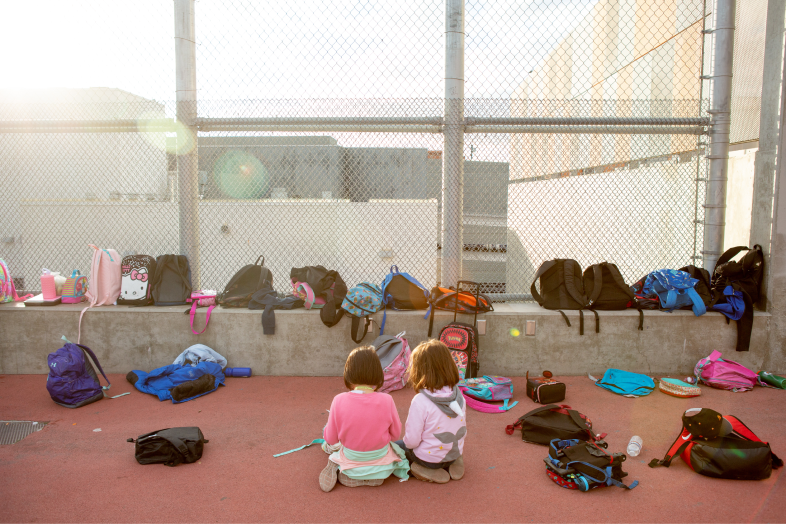Three leaders in education finance came together during a recent EWA panel to discuss what has changed in funding student education and what reporters should be paying more attention to.
The session, “The Long Game: How We Invest in Education,” took place at the 2023 SXSW EDU Conference in Austin, Texas. It focused on whether higher funding levels equate to better student outcomes, how Tennessee has revamped its school-funding formula, and the long-lasting implications of the federal COVID-19 pandemic-relief funding states and school districts received.
Moderated by The Dallas Morning News’ Education Lab Editor Eva-Marie Ayala, the March 7 panel included school finance experts: Julien Lafortune, a research fellow at Public Policy Institute of California; Penny Schwinn, education commissioner at the Tennessee Department of Education; and Michael Griffith, senior researcher and policy analyst at Learning Policy Institute.
Changes in How States Fund Schools and Students
Does money matter?
That question was at the heart of a longstanding debate for many years, Lafortune said. But thanks to more research, backed by better data and better methods, he said, there is proof that more money can, on average, lead to improved academic and life outcomes for some students.
The more important question researchers are trying to answer now is how districts can ensure they are getting the biggest bang for their buck, Lafortune said.
That has been the focus for Tennessee, with the latter question guiding its massive overhaul of the state’s school-funding formula.
The change, Tennessee Education Commissioner Schwinn said, was to revamp the 30-year-old formula – Basic Education Program – into one that is student based.
Now, the new formula, Tennessee Investment in Student Achievement, includes weights for students who are economically disadvantaged, who have a disability (including dyslexia), or who are English Language Learners. Thus, each student in the state starts at a base rate of $6,860, with more money added for those who will need additional support. The new formula moves away from equal funding to equitable funding.
Additionally, the formula includes financial incentives for districts to reach higher academic outcomes for their students.
To get this passed, Schwinn said, policymakers weren’t just concerned with whether the state had enough money, but rather, “Can you link it to outcomes?”
Griffith of the Learning Policy Institute said more people, like those in support of Tennessee’s new formula, understand that high-needs populations need more funding. The issue, though, is that many education leaders are still lumping these populations together as “at-risk,” he said.
“Students experiencing homelessness, foster youth, migrant students – each of those should be thought about as a different group in your funding formula,” Griffith said, adding that only four states currently provide additional funding for homeless students.
Griffith also spoke about a change that is building momentum, even if temporarily: states funding schools based on student enrollment rather than student attendance, which had previously been the trend for years
The reason, he said, is tied to COVID and how it continues to impact how many students physically attend school.
Covering ESSER Spending
The speakers also spoke about how districts have spent their Elementary and Secondary School Emergency Relief Fund (ESSER) funds, with Lafortune explaining that California schools have spent about 60% so far.
Given the unprecedented amount of flexibility districts had in spending these dollars, analyzing how they were spent and if those decisions were the best for students has been a strenuous task for researchers (and reporters).
Initially, many districts spent their federal funding toward health and safety initiatives, then technology associated with distance learning. More recently, the trend has been to spend the money on instructional interventions, additional instructional time and mental health supports, according to Lafortune.
One issue some districts are bound to start facing is related to staffing and whether or not they can support the salaries of staff hired with federal dollars once that money expires, he said.
Another category many districts put a lot of money toward was facilities. Georgetown University’s Edunomics Lab is working on launching a new tool that will help reporters track that specific category.
Griffith, on the other hand, said he is less worried about how districts spent their ESSER funds and more worried about how they will fare financially in the next couple years.
“If we see this money running out and we have a dip in the economy, we could really start to see some issues,” he said, indicating this is one of the bigger stories he’d like reporters to pursue.
The other big story, he said, is that the pipeline of young people entering the education profession is drying out.“Without teachers, we are really stuck. They are education,” Griffith said.
School Finance Story Ideas
- Are there homeless students in your state, and does your state’s school funding formula provide extra funding for this population?
- What should you know about your state’s school funding formula? Is it based on enrollment or attendance?
- Dyslexia: Kentucky doesn’t screen for it, but researchers believe about 20% of the population has the disorder. What’s going on (financially) in your state?
- How did your district spend its ESSER funds?
- How many positions in your district are currently funded by ESSER dollars? What’s next?
- Facilities: Did your district improve them through ESSER funds?
- An economic downturn is happening: Can your district survive a recession?
- With a teacher shortage, what is your state/district doing to attract more educators into the profession?

